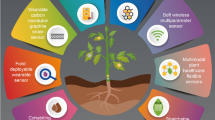Summary
The study was conducted to identify plant characters associated with seed yield in close soybean plant spacings. Lines selected from two F6 soybean populations in the F10 generation segragating for degree of stem termination were grown in two locations. Traits measured included lengths of developmental stage. plant and canopy height, number of nodes, lodging at different stages, raceme lengths, and number of nodes and branch number of nodes.
One problem in analyzing data and drawing conclusions from such a study is related to the complex nature of the interrelationships of a large number of traits. Another, not unrelated problem, involves the calculation of multiple-regression equations with multicolinearities. Because of these problems, factor analysis was used to study the correlation matrix to identify sets of variables related to the same biological concept or function. The variables within sets were determined for each stem termination type, and measurements of these variables were standardized. Means were calculated by using the sum of the standardized variables for each set. Multiple regression was used to study the relationships between sets as the independent variables and yield as the dependent variable. Individual traits were selected from within each set and substituted in the multiple regression equations calculated with the mean value for each set. With use of this technique to determine multiple regression equations, the resulting equations involved measurements of different biological functions instead of repeated measurements of the same function in the plant. It was found that, in the determinate stem type, the measurement of the seed-filling period and branch number of nodes could possibly be used to predict yield while, in the semideterminate stem type, the measurement of the ‘fixed capital’ function and terminal raceme length were possibly useful. Finally, in the indeterminate stem type, the measurement of the ‘fixed capital’ could be used, but it had a very low predictive value.
Similar content being viewed by others
References
Bernard R. L., 1972. Two genes affecting stem termination in soybeans. Crop Sci. 12: 235–239.
Camper, H. M. & T. J. Smith, 1958. The effect of date of planting, rate of planting and width of row on two soybean varieties. Va. Agric. Exp. Stn. Res. Rep. 21.
Chang J. F., D. E. Green & R. Shibles, 1982. Yield and agronomic performance of semideterminate and indeterminate soybean stem types. Crop Sci. 22: 97–101.
Cooper R. L., 1971. Influence of soybean production practices on lodging and seed yield in highly productive environments. Agron. J. 63: 490–493.
Daultrey S., 1976. Principal componant analysis. CATMOG. Geo. Abstracts Ltd., University of East Anglia, Norwich, England.
Denis J. C. & M. W. Adams, 1978. A factor analysis of plant variables related to yield in dry beans. I. Morphological traits. Crop Sci. 18: 74–78.
Donovan L. S., F. Dimmoch & R. B. Carson, 1963. Some effects of planting pattern on yield, percent oil, and percent protein in Mandarin (O Hawa) soybeans. Can. J. Plant Sci. 43: 131–140.
Green D. E., P. F. Burlamaqui & R. Shibles, 1977. Performance of randomly selected soybean lines with semideterminate and indeterminate growth habits. Crop Sci. 17: 335–339.
Gunst R. F. & R. L. Manson, 1977. Advantages of examining multicollinearities in regression analysis. Biometrics 66: 249–260.
Hartwig E. E., 1957. Row width and rates of planting in the southern states. Soybean Digest 17(5): 13–16.
Hartwig E. E. & C. J. EdwardsJr., 1970. Effects of morphological characters upon seed yield in soybeans. Agron. J. 62: 64–65.
Hicks D. R., J. W. Pendleton, R. L. Bernard & T. J. Johnston, 1969. Response of soybean types to planting patterns. Agron. J. 61: 290–293.
Lehman W. F. & J. W. Lambert, 1960. Effects of spacing of soybean plants between and within rows on yield and its components. Agron. J. 52: 84–86.
Littlejohn D. A. & A. D. McLaren, 1978. The effect of row width and population on the performance of semi-dwarf and indeterminate soybean types. Can. J. Plant. Sci. 58: 583.
Moraghan, B. S., 1970. Plant characters related to yield response of unselected lines of soybeans in various row widths and populations. Univ. Microfilms No. 71-7311. Ann. Arbor, MI.
Mostellar F. & J. W. Tukey, 1977. Data analysis and regression. Addison-Wesley Publishing Co., Reading, Mass.
Shibles R. M. & C. R- Weber, 1965. Leaf area, solar radiation, interruption, and dry matter production by soybeans. Crop Sci. 5: 575–577.
Soll J. P., 1979. SAS user's guide. SAS Institute, Raleigh, North Carolina.
Walton P. D., 1971. The use of factor analysis in determining characters for yield selection in wheat. Euphytica 20: 416–421.
Wiggans R. G., 1939. The influence of space and arrangement on the production of soybean plants. J. Am. Soc. Agron. 31: 314–321.
Wilcox J. R., 1974. Response of three soybean strains to equdistant spacings. Agron. J. 66: 409–412.
Wilson, R. R. & R. H. Cole, 1968. The potential of dwarf soybean varieties. Dela. Agric. Exp. Stn. Bull. 367.
Author information
Authors and Affiliations
Additional information
Journal Paper No. J-11003 of the Iowa Agriculture and Home Economics Experiment Station, Ames, Iowa. Project No. 2446.
Rights and permissions
About this article
Cite this article
Bramel, P.J., Hinz, P.N., Green, D.E. et al. Use of principal factor analysis in the study of three stem termination types of soybean. Euphytica 33, 387–400 (1984). https://doi.org/10.1007/BF00021136
Received:
Issue Date:
DOI: https://doi.org/10.1007/BF00021136




